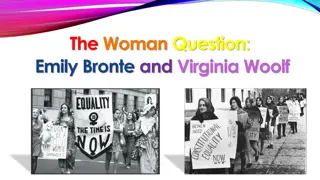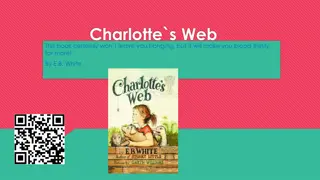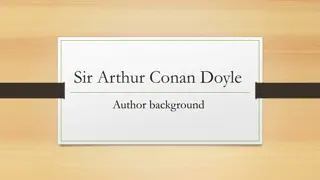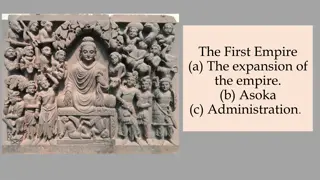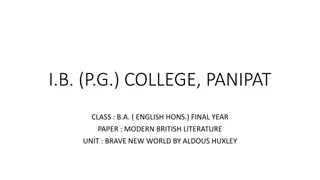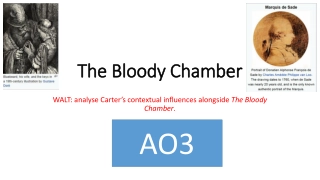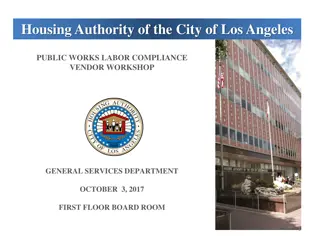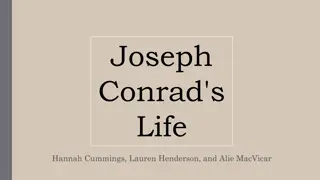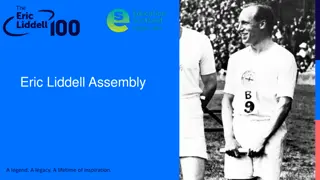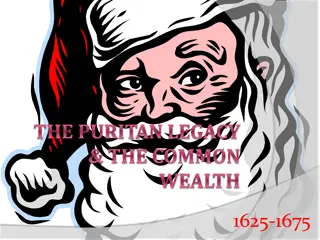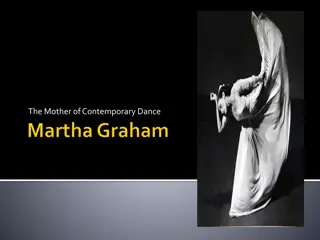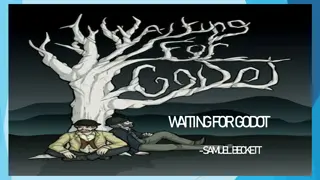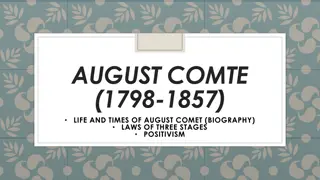Charlotte Brontë: Life, Works, and Legacy
Charlotte Brontë, a pioneering Victorian fiction writer, created heroines reflecting her own character traits while challenging societal norms. Together with her sisters, Elizabeth and Emily, she delved into themes of passion, duty, and individualism in their novels set against the backdrop of the Yorkshire moors. Charlotte's most famous work, "Jane Eyre," follows the journey of a strong-willed orphan who defies conventions to pursue liberty and self-fulfillment. Explore the life, writings, and feminist legacy of Charlotte Brontë and the Brontë sisters in this insightful overview.
Download Presentation

Please find below an Image/Link to download the presentation.
The content on the website is provided AS IS for your information and personal use only. It may not be sold, licensed, or shared on other websites without obtaining consent from the author. Download presentation by click this link. If you encounter any issues during the download, it is possible that the publisher has removed the file from their server.
E N D
Presentation Transcript
Charlotte Bront: a new Victorian fiction She was the first to make the novel vehicle of personal revelation, her main characters refletc some of her personality traits. Her heroines have her same sense of duty and her moral uprightness. But, at the same time, like her, they do not hesitate to reveal their own passions, which struck a society still imbued with Victorian prejudices.
The Bront sisters and their common features The Bront sisters (Elizabeth, Emily and Charlotte) share some features among themselves which lead us to think of them and their works as a group. They reproduced the violent conflictual passions which tear the human soul; they exalted the uniqueness of the invidual with his freedom and his emotions, negleting the social spirit Their stories were set in wild landscapes of the Yorkshire moors They were attracted by the savage, the exotic and the mysterious
Charlotte Bronts life Charlotte had 3 sisters (Emily, Maria and Elizabeth) and a brother. They were children of an Irish clergyman. They lived in a lonely and isolated place in Yorkshire and were educated at home. After their mother s death they were sent to school, where the discipline was very strict and the atmosphere very gloomy. Maria and Elizabeth died of tuberculosis After working as a governess, Charlotte went to Brussels to learn French and then worked there as a teacher In 1854 she married, but her husband died one year later, at 39. She published Jane Eyre in 1847 and it was scandalous because it focused on the passion of a respectable woman.
Jane Eyre: the plot Jane Eyre tells the story of an orphan girl who grows up in a hostile house: she spent her childhood with her aunt and then at a boarding school for the poor. She becomes a governess to a child at the home of the rich Mr. Rochester. She falls in love with Rochester and they are about to marry but just before the wedding she finds out that he is already married and that his crazy wife, Bertha Mason, is hidden in the attic. Jane doesn t want to be Rochester s lover, so she leaves him. At the end, when Berta dies after burning their house, Jane goes back to Rochester (who has become blind) and also gets an inheritance.
Jane Eyre: the character I desire liberty; for liberty I gasped; for liberty I uttered a prayer and I will be myself Jane can be considered the symbol of the new woman who overcomes the impediments imposed by conventions and hypocrisy to reach freedom and self-fulfillment; She doesn t reflect the conventional Victorian image of the woman, seen as an angel of the home, Jane Eyre is a new kind of heroine: she is an independent and unconventional woman
Jane Eyre: the character (1) Women are supposed to be very calm generally: but women feel just as men feel; they need exercises for their faculties and a field for their efforts as much as their brothers do Jane appears to be a feminist ante litterm, she expresses her anger for a male-oriented society, where women have few possibilities to express their personality. She wants to go beyond the roles attributed to women at the time.
Jane and her sexual passion Most true it is that beauty is in the eye of the gazer. My master s colourless, olive face, square, massive brow, broad and jetty eyebrows, deep eyes, strong features, firm, grim mouth, all energy, decision, will, were not beautiful, according to rule; but they were more than beautiful to me: they were full of an interest, an influence that quite mastered me, that took my feelings from my own power and fettered them in his. I had not intended to love him: the reader knows I had wrought hard to extirpate from my soul the germs of love there detected; and now, at the first renewed view of him, they spontaneously revived, green and strong! He made me love him without looking at me. (Che la bellezza sia nell occhio di chi guarda una grande verit . Il viso pallido, olivastro del mio padrone, la fronte dritta e massiccia, le folte sopracciglia, gli occhi scuri, i lineamenti marcati e la bocca severa risoluta, energica, volitiva non erano belli secondo i canoni consueti di bellezza; ma per me erano pi che belli: avevano per me un interesse, avevano su di me un influsso che mi dominava, che toglieva al mio potere i miei stessi sentimenti e li incatenava al suo. Non era stata mia intenzione guardarlo: chi mi legge sa quanto avessi combattuto per estirpare dal mio animo i germi dell amore che vi avevo scoperto; e ora, appena lo aveva rivisto, i germi del mio amore risorgevano spontaneamente, vivi e forti. Anche senza guardarmi, mi costringeva ad amarlo.)
Jane and her sexual passion (1) In this passage is depicted a woman who dares to show openly her inner self, full of desire and love, a woman who had the courage to claim the right of her sex to freedom and action. A very remarkable passage because of Jane s frank admittance of overwhelming physical attraction.
Jane and Bertha: complementary figures Bertha is Jane s double, the crazy perturbating element which is not socially accepted, because free from any conventions and moved by animal instincts. Jane s duality is the leitmotiv of the whole novel and is underlined by the opposition of contrasting elements, like light and darkness, ice and fire, spirituality and sexuality, insiede and outside. Her personality is spilt between, on one hand, her restless, sexual unease and then fulfillment, and, on the other hand, the idea of sacrifice and self-abnegation
Mr. and Mrs. Rochester Rochester is also a particular hero: he is hard, rough and not handsome, not the typical romantic hero. Because of this dark and mysterious appearence, he is fascinating. He reveals to Jane his true personality: he is very sensitive and thoughtful. Bertha is presented as mad, aggressive and dangerous for the others and for herself: in fact at the end of the story she sets fire to the house.
Gothic atmosphere in a Bildungsroman Jane in Jane Eyre has to face several difficulties from childhood to the adulthood but the final happy ending marks a complete and successful growth of the character. This novel is not a Gothic novel in the complete sense of the word (Gothic novels were set in past lands and presented supernatural, mystery and terror elements, like Horace Walpole s Castle of Otranto), but has some elements of the Gothic novel: 1) There is a mystery about Rochester s past; 2) There is a ghostly atmosphere in his house; 3) There is the appearance of a fortune-teller; 4) There is the secret of Bertha in the attic. 5) Also the love between Jane and Rochester can be considered a typically Gothic element.


